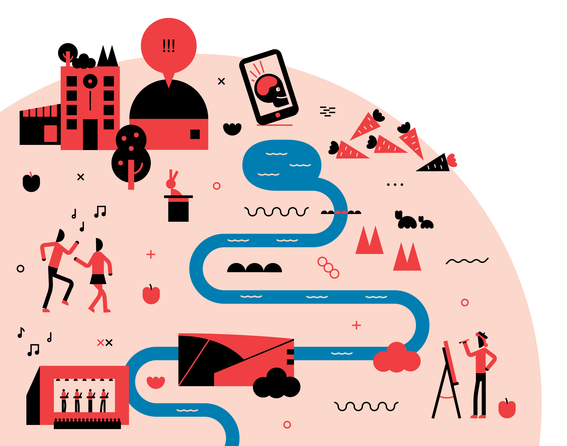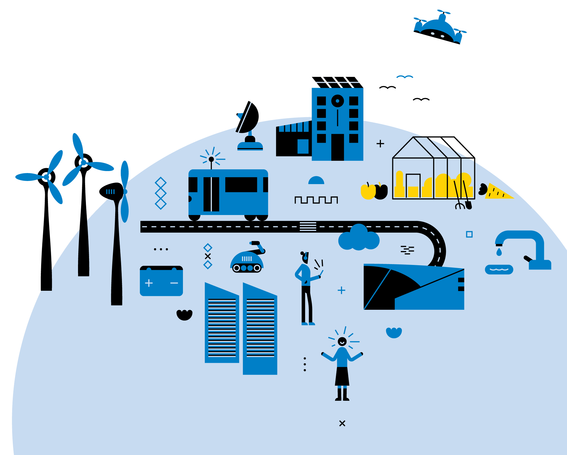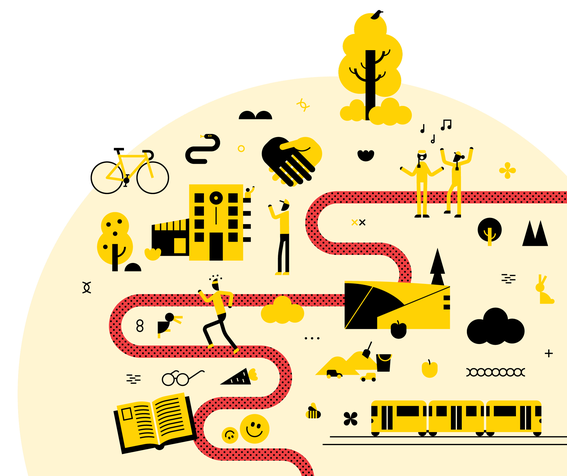Aalto University campus 2050
It's hard to visualise the changes that will have taken place by 2050 – who, for example, would have been able to predict 32 years ago the founding of Aalto University? And who in 1986 saw the potential of the internet and the importance of mobile phones? The current development vision stretches only to 2021, and so now the sights are being set on the mid-point of our present century. Three alternative visions are under development for the future development of the campus as a whole.

1 Community Works
Otaniemi has become a more compact and diverse local district in which old and new buildings are woven together to form an unique fabric. At the same time, it has shaped up to become a centre of cultural life. Cultural networks mix with both creative communities and also long-established technology and business networks. Art and design organisations together with their members and workers attract visitors and social actors to the area.
The campus offers for people of different ages a lifelong learning environment which favours forms of experimental learning and teaching and which support learners and researchers. Otaniemi is one of Finland’s most international local districts, and its community-orientated planning mechanisms are imitated elsewhere.
The multifaceted reuse of old laboratory buildings attracts new users to Otaniemi. Old buildings offer spaces for artists and workshops for experimenting with new technologies. The hybrid buildings and quarters that flexibly mix different activities support human interaction. Local identity is built up through both the urban culture and artistic offerings. There are many different kinds of events, and people come to Otaniemi from far away.
The district’s ecosystem services support urban culture, for example through the addition of city gardens and roof gardens. It has been possible to alleviate the worst effects of climate change through artful environmental planning. Otaniemi’s different neighbourhoods have radically different identities and environments.

2 Information Resort
The campus is a Nordic hub of entrepreneurship, innovation and top-level education. The local district is known internationally for its abundance of new patents, multidisciplinary skills and new business models.
‘Otaniemi is only lacking a birthing hospital’, is an often-heard phrase which emphasises the area’s self-sufficiency. A diverse range of amenities and services are available 24/7 to campus users and residents. Automatic transport options have removed the need for parking areas.
The campus is more compact, and many building plots have been repeatedly rebuilt for decades, so many blocks on the edge of the campus are already pretty high-rise. Advanced building technologies are used to combine old and new in imaginative ways. Energy production, energy storage and food production on the campus have been maximised.
Climate change has been combated using cutting- edge technology. The campus has also seen the development of smart antennas which help to protect against wind and enable complete, real- time management of air-conditioning, water and energy use. The challenge, however, comes from the systems’ energy use and continual need to be updated.

3 Health Wave
Otaniemi’s renowned well-being campus has grown to become part of the urban tapestry of Helsinki and Espoo, but has also succeeded in retaining its village feel. Familiar faces greet passers-by, and the area is imbibed with an accepting and lively culture which supports quality-of-life and well-being. The student culture is very active and gives the area its own unique identity.
The campus’s harmonious and beautiful surroundings bring wholeness to both a human mind torn by digitalisation and to people’s fragmented timetables. The campus also has digital-free areas where visitors can focus on their thoughts without being distracted. The architecture and outside areas have retained their traditional, clear features. Together with its partners and students, the university develops the campus’ new and innovative residential areas that support meaningful social and private life for different groups.
In the Otaniemi campus area, well-being is central, and the area is known for its splendid outdoor spaces, clean-air and human-centred lifestyle which seeks out a good balance between work and free time. These factors attract the best from around the world to come to study and work on the campus. The well-being campus boasts creativity and quality-of-life. Otaniemi’s natural qualities are supplemented by luscious gardens, parks, courtyards and walkways. There is a wider variety of natural habitats than before, ranging from wetlands to meadows, and the most significant effects of climate change have been dealt with by combining cost-effective natural alternatives with innovative but expensive technological methods.
People get around the campus using either automatic transport or on foot, and trips outside of the campus are made by rail. Otaniemi has a comprehensive and diverse network of recreational routes which help to tackle the health problems caused by automation and also attract visitors from different parts of the metropolitan area. Along these routes can be found sports areas, play areas and other recreational areas for all different ages.






